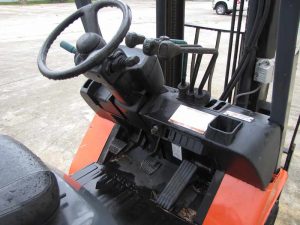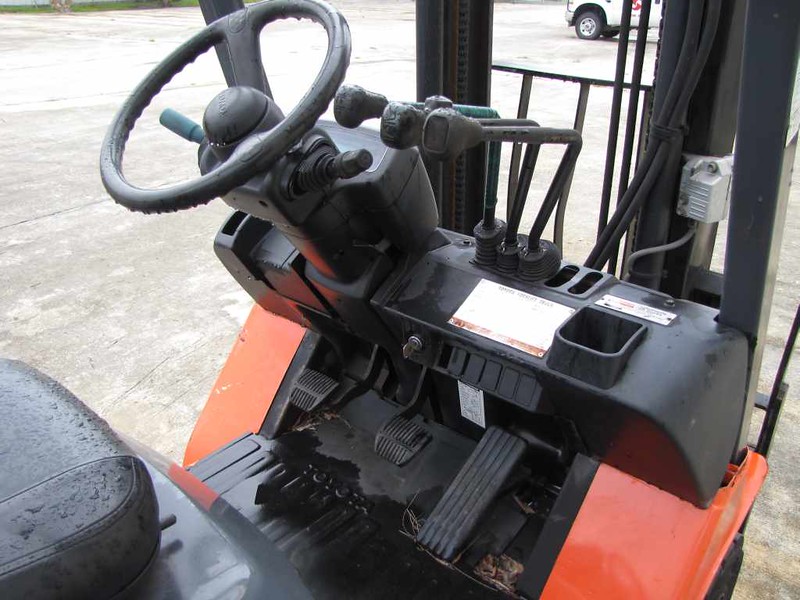Troubleshooting Common Problems With A Forklift
If you’re new to the trade of driving forklifts, then you may not yet have encountered all of the common problems that plague the machine. If you’re fairly experienced with forklifts, then you may have learned about the common problems, but still don’t know how to fix them.
In this article we will discuss common problems of forklifts, how to troubleshoot them to identify the reason for the problem and then how to fix it.
Common problems that plague forklifts include:
• Mast Issues
• Starting Problems
• Steering
• Tire And Suspension Issues
Mast Issues
The mast, as you no doubt know, is the lift mechanism and frame of a forklift. Problems that plague it include not properly lifting or lowering items.
The problem could be due to a fluid leak that affects the load lift capacity of the lift. Too little hydraulic fluid will not produce enough power for the mast to lift heavy items or may adversely influence other mast movements.
The problem could also be debris in the hydraulic system that is causing a clog.
To troubleshoot this issue, first is to check to see if the forklift has enough oil to function the hydraulic lift.
An oil leak of this kind can wear out the hydraulic system and can limit the mobility of the forklift. If not repaired quickly, the leak could be the prelude to even worse problems. An oil leak of just one drop per second would result in a loss of 420 gallons of oil a year. So, it is imperative to properly troubleshoot this issue, isolate the problem and fix it.
In this case, the culprit could be the cylinder of the hydraulic lift. If that’s the problem, replace the defective part to assure better performance of the forklift and ensure safe operation going into the future.
If you don’t find a leak, then replace the hydraulic fluid with fresh fluid.
Starting Problems
A common problem with starters of electric forklifts is not starting. To troubleshoot this issue, it’s suggested that you check to see that the battery is adequately charged or whether there is circuit problem in the electrical system of the lift.

Toyota forklift interior.
(Courtesy: John Winkel at flickr.com)
It’s not uncommon for forklifts to experience temperature fluctuations as well as contact to chemicals that adversely affect the cooling system. This can lead to corrosion, cracking, or chemical deterioration. A troubled cooling system can overheat the forklift system causing its subsequent shutdown.
So, if your forklift won’t start, check the cooling system components to assure that they are in proper working order. And, to prevent issues with the starter in the first place, add an inspection of the lift’s cooling system to your regular maintenance routine.
The troubleshooting of starting problems should also include a check of the battery and analysis of the electrical system.
If the starting problem occurs on an internal combustion forklift, then perform these troubleshooting activities.
• If the fuel has been in the forklift’s tank for a long period of time, flush it out and replace with fresh fuel.
• If you sniff the scent of gasoline, then there could be a fuel leak.
• Check the oil levels. Some forklifts won’t allow the fuel valve to open if there is not enough oil in the engine
It’s suggested that you clean the radiator if it needs it. If you spot corrosion on the radiator, replace it.
Steering
Steering problems with your lift may not happen a lot, but when it does it can become a chronic and risky issue. If you hear strange noises while you turn the wheel, especially when the lift is loaded, then there’s obviously a problem.
The noise could be a sign that there is rust in the steering mechanism. It could also be a problem with the hydraulics that regulates steering pressure. Other causes of the problem include loose or worn pressure valves, worn gears, too little steering fluid, or misaligned tires.
If the steering fluid transmission is low, add more. If the fluid is thick and greasy, then change the fluid. Worn out gears or hydraulics need to be replaced.
Tires And Suspension
The performance of the tires can affect the lift’s suspension and the lift’s suspension can affect the tires. Worn tires can make problems worse and cause handling problems of the lift. A damaged suspension, on the other hand, can adversely affect the entire vehicle. Moreover, the load can compound suspension problems.
Troubleshooting the problem can be a lot more complicated. Of course, check the tires for wear and if spotted replace them. If the tires aren’t the issue, then an inspection of the suspension will be necessary. In this case, it would be best to have a professional mechanic repair the problem.
Perform Regular Maintenance
Regular maintenance of the forklift could prevent sudden issues that require troubleshooting. Regular maintenance should be proactive and planned. If you don’t do the things necessary to prevent a breakdown, then the result is costly down time.
Today’s warehouse management software systems allow you to set up maintenance schedules. Once you have a schedule, it is so much easier to implement it. You can also keep track of maintenance on each forklift of your fleet and create a repair history of each lift.
To be certain that there are no surprises concerning your forklift that cause troubleshooting activity, inspect the lifts daily. It will save you money, time, and help ensure safety.
Preventive maintenance should include:
• Checking tire pressure.
• Changing the oil every three months.
• Checking antifreeze levels to prevent overheating or freezing.
• Replace brake pads and calipers when necessary.
(Sources: medium.com, aussieforkliftrepairs.com, and certifyme.net)

